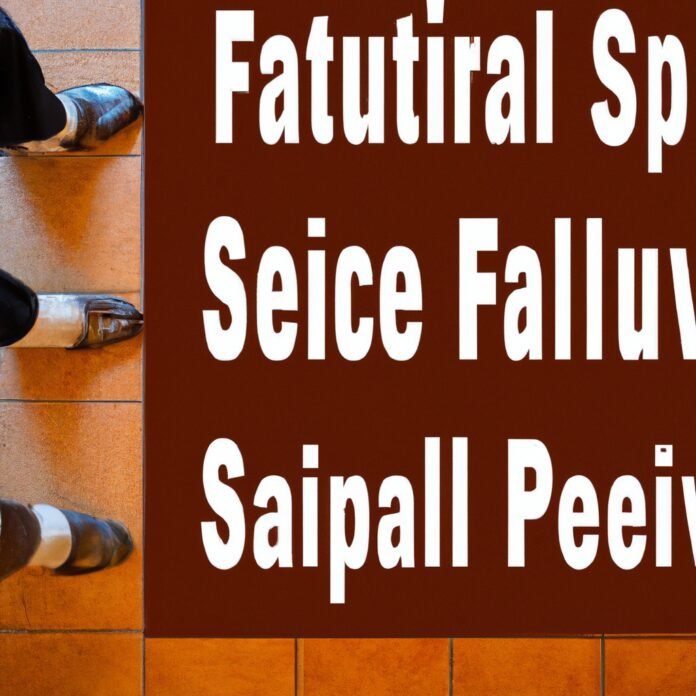As we get older, safety and security become increasingly important. Not only are falls more common among the elderly, they can also prove to be dangerous and even deadly. To prevent this, it is important to create an environment that promotes safety and good physical health for the elderly individuals who inhabit it. In this article, we take a look at how the right strategies and preventative measures can help reduce the risk of falls and build a secure environment for the elderly.
1. Understanding the Risks and Challenges of Elderly Fall Prevention
Falls among the elderly are all too common, and they can have serious consequences. It is an unfortunate reality that falls leading to hospitalization or death are all too common, and more must be done to ensure elderly people are safeguarded against them. Knowing the risks, challenges, and measures that can be taken to reduce them is important to ensure elderly people lead safe and healthy lives.
The Risks of Falls
- Diminished balance or coordination
- Chronic medical conditions
- Reduced vision
- Depression or anxiety
- Medication side effects
- Poorly fitted shoes
- Use of canes, walkers, or wheelchairs
These are some of the various factors that, if present, may increase the chances of elderly people taking a tumble.
Challenges to Elderly Fall Prevention
One of the biggest challenges associated with elderly fall prevention is the feeling of stigma that surrounds it. Elderly people may not want to use a cane or other walking assistance device, or readily admit to being weaker or less balanced than they once were. Additionally, they may be unwilling to modify their homes or lifestyles for fear of taking away their independence.
The challenges of elderly fall prevention are significant, but there are recognized measures that can be taken to reduce the falling risks. Early intervention and assessment are among the biggest keys to safeguarding elderly people from falls, and should be considered essential in any elderly fall prevention plan.
2. Creating a Home Environment for Safe Senior Living
Creating a safe and welcoming home environment for seniors requires careful thought and consideration. Although no space is ever entirely risk-free, there are plenty of steps that can be implemented to ensure a safer and more comfortable living space for seniors. Here are some tips to get you started:
- Improve accessibility: Making everyday tasks easier for seniors decreases the risk of injury caused by falls, trips, and strains. This can be done by adding ramps or grab bars, widening hallways, or introducing step stools and ergonomic furniture.
- Stick to the basics: This means removing clutter and moving furniture away from walkways. Additionally, make sure that all floors are properly vacuumed and mopped to ensure no slippery surfaces.
- Promote independence: Give seniors the opportunity to still complete tasks and chores around the home by providing access to items without them having to reach for them or move furniture.
By investing in the safety and comfort of seniors at home, you will be taking a giant step in the right direction. With these small changes, you can create a more stress-free living environment and make senior living much safer and enjoyable.
3. Making Lifestyle Changes to Reduce the Risk of Falling
Falls are often preventable, and the answer may be as simple as making a few lifestyle changes. Here are some great changes you can make to reduce your risk of falls:
- Staying active – Regular physical activity can help to keep muscles strong and joints flexible. This increases balance and can reduce the risk of falls.
- Correcting vision problems – Having poor vision can increase the risk of a fall, so it’s important to ensure your eyesight is up to date and your glasses are working properly.
- Improving your living environment – Simple changes such as making sure your home is well-lit and clutter-free can make a big difference.
- Managing medications – Some medications can increase the risk of falls, so it’s important to talk to your doctor about any medications you take regularly.
Falls are serious, but they are also preventable. Making even small lifestyle changes can help reduce your risk of a fall and keep you on your feet.
By focusing on health, fitness, and safety, you can improve your balance and stability and protect yourself against falls. Make sure to talk to your doctor about any concerns you might have about falling, and take steps to reduce your risk today!
4. What Resources Are Available to Provide Fall Protection?
Workers at height need to be protected from the dangers of a fall. In order to do this, there are several resources and measures available to provide fall protection.
Guardrails. A guardrail is a simple but effective fall protection resource. It is a barrier between the worker and the fall, such as a railing along the edge of a roof. In accordance with OSHA, guardrails must have a top rail 42 inches (1.1 m) above the surface of the walking or working surface and a mid-rail halfway in between the top rail and the working surface.
Safety nets. Safety nets are a versatile fall protection resource that can be used in place of guardrails and other resources. They are net-like systems that are installed around the work area and provide a cushion for workers in the event of a fall. Safety nets must meet minimum standards for size (5 x 7 feet), spacing, breaking strength, and design.
Safety harnesses. Workers working at height should be tied off to something sturdy to avoid a fall. A safety harness provides the best protection as it can be securely attached to a solid object. Harnesses should be inspected for wear and tear regularly as they are essential safety equipment.
Anchor points. An anchor point is a secure location for connecting your safety harness to an anchor system. Anchor points can be stationary or mobile and must be mounted securely. Appropriate anchor points must be provided for each work area to provide fall protection.
Using a combination of these fall protection resources will ensure the safety of workers in an elevated working environment. It is important to utilize a reliable system that meets the applicable safety standards in order to provide the best protection.
5. Ways to Promote Fall Prevention and Increase Awareness
1. Enable Fall Prevention Technology
Fall prevention technology is an important way to promote such awareness. Devices like personal alarms, wearable sensors, and automated fall monitors can be installed in the home to detect falls quickly and alert caregivers or medical professionals promptly, even when the person who has fallen cannot call for help. Such technology helps to ensure that the person who has fallen is efficiently taken care of and that any injuries can be quickly addressed.
2. Participate in Fall Prevention Programs
There are a range of fall prevention programs that healthcare professionals can participate in to spread awareness. From local community events to online health talks, physicians, nurses, and other healthcare professionals can join in and provide detailed information about the risk factors and approaches to preventing falls among seniors. The more comprehensive the information they provide, the more seniors and their families will be able to protect themselves and those they care about from fall-related accidents.
3. Spread Fall Prevention Information
Healthcare professionals can also share fall prevention information through social media, newsletters, and other platforms. Through these outlets, simple advice on how to introduce safety measures to reduce the risk of falling can be shared effectively with the wider public. Tips such as keeping floors clean and dry, improving lighting, and maintaining good posture while moving around can be shared to help prevent falling accidents.
4. Educate Caregivers and Family Members
Caregivers and family members who spend more time than most with elderly individuals are key to raising awareness about fall prevention. These individuals can be taught to identify potential trip hazards and remove them, install railings in bathrooms and on stairways, and keep a close eye on the elderly person to ensure that they are not engaging in activities that would put them at risk of falling. By doing all these things, caregivers and family members can help to ensure that seniors are taken care of and that they are being protected from falls.
The elderly population are members of our society with years of experience, contributions and knowledge to pass down; it’s our duty to ensure their quality of life is securely sustained. With awareness of the risks associated with falls and the implementation of safety precautions, the security of our elderly family, friends and neighbors can be sustained for years to come.

